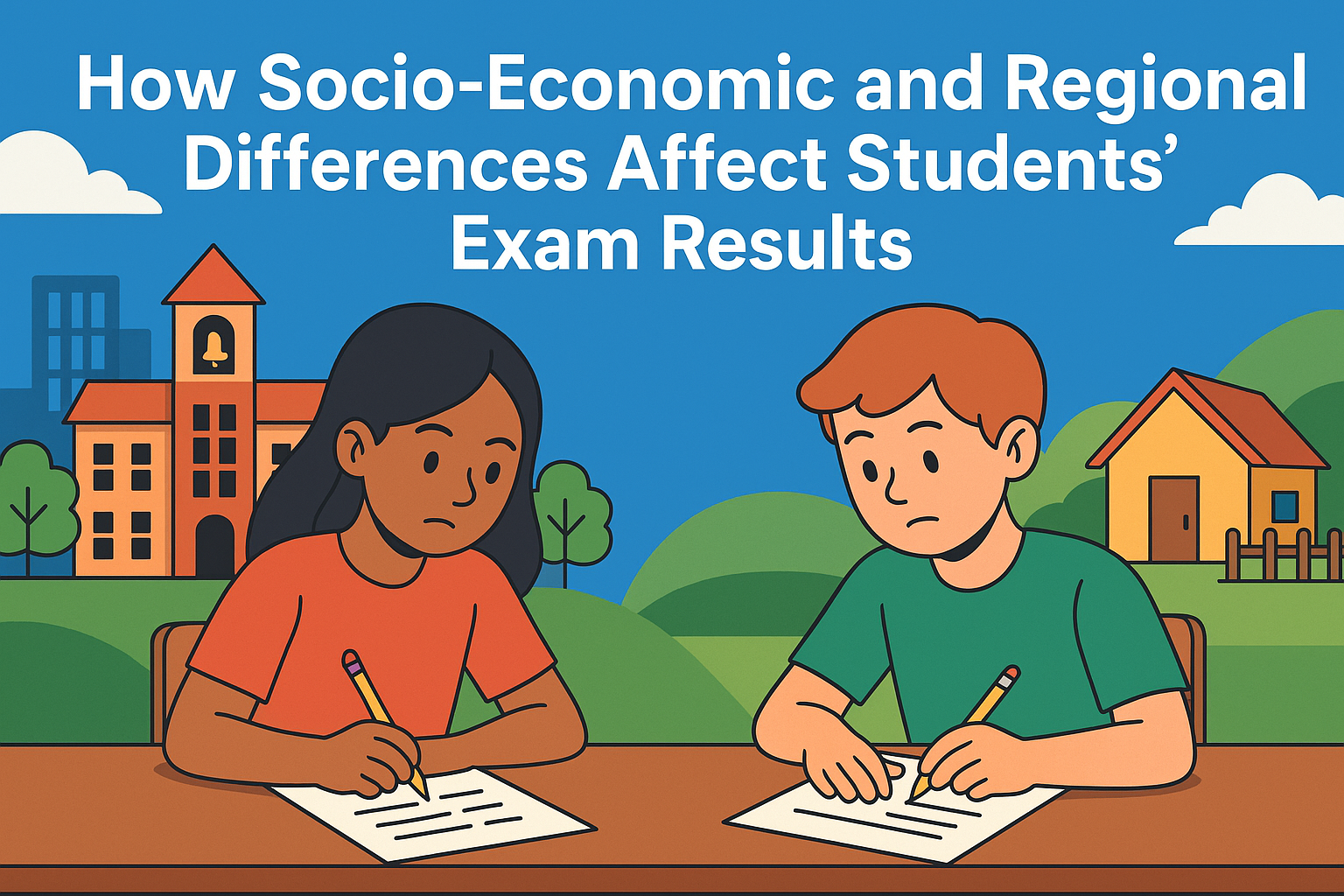Every child dreams of good exam results. Good grades show academic achievement, learning, and success in school. But all students get the same opportunity. Some children are well supported and at home. Some do not. This creates socio-economic and regional differences.
These differences change how students study and their exam performance. Let us learn in simple words.
What Is Socio-Economic Status?
Socio-economic status means a family’s income, education level, job type, and social class. It decides:
- Money for school fees, books, and coaching
- Good nutrition and health
- Quiet place to study
- Good learning tools, like a laptop/internet
When a family has a low income or lives in poverty, the student may face more difficulty in studying and exam preparation.
Regional Differences in Education
The same educational resources are not provided to students in different areas and locales. For instance:
- Smart labs and classrooms can occasionally be found in large city schools.
- There may be fewer facilities and teachers in rural schools.
- Coaching facilities and reliable internet are lacking in some places.
- For school, students from isolated areas might have to travel a considerable distance.
- Exam outcomes, learning, and study experiences are all impacted by these variations.
Simple Example
Imagine two students:
| Student | Place | Family Income | School Facilities | Result |
|---|---|---|---|---|
| --- | --- | --- | --- | --- |
| Riya | Big city | High Income | Big school, labs, coaching | High Marks |
| Mohan | Small Village | Low Income | Small school, fewer teachers | Tries hard but scores less |
They are both intelligent. However, because they have various opportunities, their academic performance is also diverse.
How These Differences Affect Students
| Area | Rich Background Students | Low-Income Students |
|---|---|---|
| Books & Study Material | Buy easily | May share or borrow |
| Internet & Laptop Access | Mostly Available | Often not available |
| Extra Classes / Coaching | Can join a good coaching | May not afford |
| Learning Environment | Quiet room, Desk | Crowded space, work duties |
| Nutrition & Health | Healthy food | Sometimes weak health |
| Confidence & Motivation | High support | Pressure, stress |
Because of this, students in poverty or low-income classes may face:
- Stress
- Low confidence
- Less time for study due to working from home
- Fewer learning resources
This can affect exam performance and school achievement.
Impact of Gender and Cultural Background
Gender can affect academic opportunities. Boys are often given greater educational opportunities than girls. However, things are getting better now. Girls are also demonstrating exam success!
Additionally, if the school language differs from the home language, students from diverse cultural and linguistic backgrounds may find school challenging.
Government Portals Helping Students
The Indian government has created numerous websites and applications to assist students from all areas and social classes:
| Portal / Scheme | Purpose |
|---|---|
| DIKSHA Portal | Free learning videos and worksheets |
| PM e-Vidya | Digital learning for all classes |
| National Scholarship Portal | Scholarships for students from low-income families |
| Samagra Shiksha | Better school facilities |
| SWAYAM Portal | Free study courses |
| e-Pathshala | Free e-books for students and teachers |
These platforms help children get equal education and access to learning.
How Schools and Parents Can Help?
| Who can help? | What they can do |
|---|---|
| Parents | Encourage study, give time, and listen to the child |
| Schools | Provide extra classes, simple notes, and friendly learning |
| Teachers | Motivate students, use easy teaching methods |
| Community | Support poor students, donate books, and help with the internet. |
Every child can shine if supported properly.
What Can Students Do?
Students can attempt these easy routines:
- Read every day: Regular reading improves understanding, builds vocabulary, and strengthens memory.
- Ask questions in class: Never hesitate to clear your doubts. Asking questions helps you understand lessons deeply and stay confident.
- Join free online classes: Use platforms like DIKSHA, SWAYAM, or Infigon Futures to learn from experts and explore new subjects at no cost.
- Study with friends: Group study helps share ideas, explain topics better, and makes learning fun and engaging.
- Practice past exam papers: Solving old papers improves speed, accuracy, and helps you understand exam patterns.
- Stay healthy and sleep well: A balanced diet, good sleep, and regular exercise keep your mind active and focused.
Remember, hard work + right support brings achievement and success.
FAQs
1. What does socioeconomic status mean?
ANS. It refers to the class, income, and level of education of a family. It has an impact on pupils' academic performance, learning, and study habits.
2. What impact does income have on test scores?
ANS. Low money restricts access to literature, the internet, and coaching, which lowers academic achievement and exam success.
3. What is the significance of regions in education?
ANS. There is a disparity in learning and test scores because different areas have different schools, teachers, and access.
4. What impact does gender have on performance?
ANS. Girls are sometimes given fewer opportunities to study, although many of them now do quite well on tests and in school.
5. How do poverty and education relate to each other?
ANS. Poverty reduces academic attainment and exam performance by limiting opportunities, study time, and school access.
6. How can schools reduce inequality?
ANS. Schools can offer equal access, free study tools, and extra help for every student’s success.
7. Why do background and class matter?
ANS. Students from educated families often get better learning support, improving their study results and achievement.

